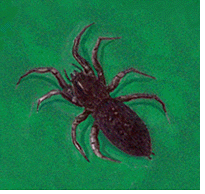...Best of Sicily presents... Best of Sicily Magazine. ... Dedicated to Sicilian art, culture, history, people, places and all things Sicilian. |
by Vincenzo Mormino | ||
Magazine Index Best of Sicily Arts & Culture Fashion Food & Wine History & Society About Us Travel Faqs Contact Map of Sicily |
There exists a long-running debate as to what constitutes a "true" tarantula. Though the term itself is a generic one, the Italian spiders are usually considered the real thing, the original tarantulas. Traditionally, tarantulas were large, hairy spiders of southern Europe, particularly the wolf spider, Lycosa tarentula in the Lycosidae family. Today, any spider in the Theraphosidae family is considered a tarantula, and this broad grouping includes American and African species, as well as Eurasian ones. The word tarantula has a southern Italian pedigree. In the Apulian coastal city of Taranto (the Greeks' ancient Taras), a form of hysteria, tarentism, known in the sixteenth and seventeenth centuries was said to result from the venomous bite of the wolf spider. In many cases, this "popular hysteria" was little more than a reaction to the increasingly strict social order imposed by the Inquisition. It eventually evolved into a lively dance for male and female partners, the Tarentella. Chopin, Weber and Liszt composed tarentellas. Tarantulas don't spin the same kind of webs as most other spiders. They live in niches they discover in abandoned buildings, or in holes they dig for themselves in the ground. Their diet consists primarily of insects such as mantises, grasshoppers or crickets. They have been known to attack small mice. Females live for as long as ten years. Tarantulas sometimes hibernate in cooler months. The occasional moulting of its body shell ("skin") is characteristic of the tarantula. Some people keep tarantulas as pets. The Sicilian tarantula is black or very dark grey, growing to an extended length (including the leg span) of over twelve centimetres (about five inches). Like most tarantulas, it is venomous, but not lethal (though its bite would be painful). It seems to prefer shade, and often ventures out at night. Tarantulas are cannibals; they occasionally eat each other. Courtship is difficult. Females have been known to devour males. About the Author: Vincenzo Mormino is active in wildlife preservation throughout Sicily. He has written about the purple swamp hen, wild cat, little egret, red fox and other creatures for previous issues. | |
Top of Page |
 Zelotes Messinai, the rare Sicilian Tarantula, boasts an interesting history. The zelotes species was identified in the nineteenth century, but the Sicilian tarantula was catalogued only in 1994. It certainly existed before this date, and references were made to large black spiders in Sicilian literature during the Middle Ages. This particular spider is linked to northeastern Sicily, but it can be found in other areas as well. Some people think spiders are insects; in fact they are arthropods of the class arachnida (arachnids).
Zelotes Messinai, the rare Sicilian Tarantula, boasts an interesting history. The zelotes species was identified in the nineteenth century, but the Sicilian tarantula was catalogued only in 1994. It certainly existed before this date, and references were made to large black spiders in Sicilian literature during the Middle Ages. This particular spider is linked to northeastern Sicily, but it can be found in other areas as well. Some people think spiders are insects; in fact they are arthropods of the class arachnida (arachnids).